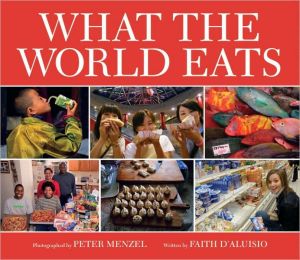What the World Eats
Sitting down to a daily family meal has long been a tradition for billions of people. But in every corner of the world this age-old custom is rapidly changing. From increased trade between countries to the expansion of global food corporations like Kraft and Nestlé, current events are having a tremendous impact on our eating habits. Chances are your supermarket is stocking a variety of international foods, and American fast food chains like McDonald’s and Kentucky Fried Chicken are popping up...
Search in google:
Sitting down to a daily family meal has long been a tradition for billions of people. But in every corner of the world this age-old custom is rapidly changing. From increased trade between countries to the expansion of global food corporations like Kraft and NestlŽ, current events are having a tremendous impact on our eating habits. Chances are your supermarket is stocking a variety of international foods, and American fast food chains like McDonald’s and Kentucky Fried Chicken are popping up all over the planet. For the first time in history, more people are overfed than underfed. And while some people still have barely enough to eat, others overeat to the point of illness. To find out how mealtime is changing in real homes, authors Peter Menzel and Faith D’Aluisio visited families around the world to observe and photograph what they eat during the course of one week. They joined parents while they shopped at mega grocery stores and outdoor markets, and participated in a feast where a single goat was shared among many families. They watched moms making dinner in kitchens and over cooking fires, and they sat down to eat with twenty-five families in twenty-one countries—if you’re keeping track, that’s about 525 meals! The foods dished up ranged from hunted seal and spit-roasted guinea pig to U.N.-rationed grains and gallons of Coca-Cola. As Peter and Faith ate and talked with families, they learned firsthand about food consumption around the world and its corresponding causes and effects. The resulting family portraits offer a fascinating glimpse into the cultural similarities and differences served on dinner plates around the globe. The New York Times - Regina Marler This amazing volume is a young adult version of their book Hungry Planet…D'Aluisio and Menzel traveled the globe, interviewing families and photographing them with one week's worth of food. From the desert village of Kouakourou in Mali, where Soumana Natomo's two wives trade off breakfast duties on alternating days, to the frozen town of Ittoqqortoormiit in Greenland, where the only fresh food is swimming under nearby ice, the images and essays in What the World Eats are completely captivating …A colorful primer on the global marketplace and cultural change, What the World Eats sparks an intellectual appetite that no amount of narwhal skin can fill.
World on a Plate\ \ Imagine for a moment that it is early Saturday morning in the United States. You have just awakened and it’s time for breakfast. If yours is like the majority of American families, your meal might consist of one or more of the following: boxed, sweetened cereal with milk; bacon and eggs; pancakes; breakfast bars; and toaster pastries. Your food probably has been purchased by your parents in a nearby supermarket. You might have an idea of the basic ingredients of the food you’re going to eat, but probably not. You move from your bed to the breakfast table and eat until you’re full.\ If, instead, you wake up in a village in the east African country of Chad, like Amna Mustapha, twelve (page 38), there are no boxes of ready-to-eat cereal, no cartons of milk, and no pastries from a supermarket bakery (in fact, there is no supermarket). You and your parents grow and raise the family’s food. Your meal is always the same—puddinglike porridge called aiysh and a thin okra soup with maybe a bit of dried goat meat for added flavor. But before you can eat it, the sorghum or millet grain for the porridge must be pounded by hand or machine milled, the water for it pulled from a distant hand-dug well, the vegetables picked fresh or gathered from the drying shed, and the wood or dried cattle dung collected to fuel the cooking fire. Children do almost all of this work for the family, although the mother usually does the cooking. Everyone gathers around to dip pieces of aiysh into the soup and eat them with their hands. Then the children leave for the day to water and tend the animals.\ Amna’s family is just one that we profiled, in twenty-one different countries, to explore humankind’s oldest social activity: eating. How would one week’s worth of food in Chad or India stack up against one week’s worth in Greenland, Mexico, the United States, Egypt, or France? We decided to find out. At the end of each visit, we created a portrait of each family surrounded by a week’s worth of groceries.\ The global marketplace has changed the way people eat. In the suburbs of Paris, French teenagers stop at McDonald’s for a quick bite and their parents shop at modern supermarkets. France’s own brands of giant supermarkets, like the American Wal-Mart, are sprouting up across the planet. In urban China, such megamarkets are replacing the bustling farmers’ markets and home gardens that for hundreds of years have provided the essentials of the Chinese diet. Traditional food and centuries-old eating habits are being replaced by "modern" energy-dense foods (like those modern breakfast foods you’re eating this Saturday morning). As societies modernize and become wealthier, people become less physically active and actually need less food. Instead, people are eating more—and getting fat.\ Even without reading the mountains of research that bear this out, the effects are easy to spot. Just look around. Many affluent countries are overfed. And, unfortunately, it seems that in developing countries, even before people attain a level of prosperity that helps ensure their adequate nutrition, they are eating in ways almost guaranteed to make them less healthy. Alma Casales, thirty-four (page 114), a young mother living in Mexico, is surprised to learn that the six gallons of Coca-Cola she, her husband, and her young children are drinking in the course of one week at all their meals and throughout the day is basically sugar water. In fewer than twenty years Mexico’s population has moved from a rate of less than 10 percent overweight to over 65 percent.\ As charitable organizations continue their campaigns against world hunger, others have started campaigns against world obesity. In the year 2000, the World Watch Institute reported that for the first time in human history there were just as many overfed people on the planet as underfed.\ So back to Amna’s breakfast in Africa, and yours in America. There is a mind-boggling number of variables to consider, but you may be surprised to learn that the breakfast in Africa could well be the more nutritious of the two. It is simply cooked and has no added fats, sugars, chemicals, or artificial ingredients. Also, the vegetables and grain didn’t travel hundreds of miles to the breakfast table—only a few dozen steps.\ Do some detective work to figure out the differences between your meal and Amna’s. Read the labels and ingredient lists of the foods you’re planning to eat. There are some things you won’t be able to discover—such as how far the bacon had to travel to get to your plate, or where the grain in your cereal was grown. Fresh fruit is easier to detect. In the modern supermarket, stickers on the fruit sometimes tell you that an apple is from New Zealand, seven thousand miles away. If you want bananas, you can get them any time of year, shipped from countries around the globe. Most of those bananas were picked long before they got ripe. Americans haven’t had to worry about whether a certain food is in season for a long time because of the elaborate transportation system developed to supply supermarkets. In Amna’s country, they get to eat fruit only when it ripens locally—juicy red watermelons available once a year.\ Why did we choose some countries and not others? Sometimes we covered a country because we were already there working on a different project; for others it was because we wanted to see something new. We covered some countries just to develop a good cross section of the world. Neither of us had been to Greenland, and we really wanted to see glaciers before they all disappear into the rising sea. It had been nearly twenty years since we worked in Ecuador, so we included this South American country to see how much it had changed. We wanted a third country in Africa, and to observe refugee life, so we traveled to Chad. And we wanted to see how Poland had survived its years of communism. We included three families in the United States to invite comparison. How do you think they compare to one another? Look at each of these families and compare your own family’s weekly grocery list to theirs. Keep in mind, though, as you look at these photographs, that none of these families is meant to be a statistical representation of the country in which they live. They represent themselves, and even then as only a snapshot in time. I wrote the stories of all these families after extensive interviews and observation in each of the countries we visited plus additional questions afterward.\ There are signs of change everywhere. Food has become a complicated business as companies compete in the global marketplace and fight for your food dollar. You have here a tool to help you understand a little more about the world around you. Bon appetit.
\ Regina MarlerThis amazing volume is a young adult version of their book Hungry Planet…D'Aluisio and Menzel traveled the globe, interviewing families and photographing them with one week's worth of food. From the desert village of Kouakourou in Mali, where Soumana Natomo's two wives trade off breakfast duties on alternating days, to the frozen town of Ittoqqortoormiit in Greenland, where the only fresh food is swimming under nearby ice, the images and essays in What the World Eats are completely captivating …A colorful primer on the global marketplace and cultural change, What the World Eats sparks an intellectual appetite that no amount of narwhal skin can fill.\ —The New York Times\ \ \ \ \ Publishers WeeklyAdapted from last year's Hungry Planet, this brilliantly executed work visits 25 families in 21 countries around the world. Each family is photographed surrounded by a week's worth of food and groceries, which Menzel and D'Aluisio use as a way of investigating not only different cultures' diets and standard of living but also the impact of globalization: why doesn't abundance bring better health, instead of increased occurrences of diabetes and similar diseases? These points are made lightly: delivered almost conversationally, the main narrative presents friendly, multigenerational portraits of each family, with meals and food preparation an avenue toward understanding their hopes and struggles. A wealth of supporting information-lush color photographs, family recipes, maps, sidebars, etc.-surrounds the text (superb design accomplishes this job harmoniously) and implies questions about global food supplies. Pictures of subsistence farmers in Ecuador cultivating potatoes from mountainous soil form sharp contrasts with those of supermarkets in a newly Westernized Poland. Fact boxes for each country tabulate revealing statistics, among them the percentage of the population living on less than $2 per day (47% in China, where the average daily caloric intake is nonetheless 2,930 per person); the percentage with diabetes; number of KFC franchises. Engrossing and certain to stimulate. All ages. (Sept.)\ Copyright © Reed Business Information, a division of Reed Elsevier Inc. All rights reserved.\ \ \ Children's LiteratureIf you have ever wondered what your counterparts around the world eat for their daily meals, some answers can be found in this impressive book. It takes a look at what a typical family in a variety of countries buys for a weeks worth of groceries. The families are pictured with the food and the cost is given in local and U.S. dollars. In addition, the foods are categorized: grains; dairy; meat, fish and eggs; fruits and vegetables; condiments; snacks; prepared food; fast food; beverages; and miscellaneous. Readers are presented with a fact box that summarizes information about the country and a presents a section of a world map to show where that country is located. The pages that follow describe life in that part of the world and how the family shops. There are also recipes of some of the traditional foods. A reader might assume that those from wealthier countries who have a variety of foods from around the world might have a healthier diet, but that is not always the case. Major and abrupt changes in diet such as those of aboriginal Australians, Native Americans and the like can bring on diseases like diabetes and issues related to obesity. The book is a treasure trove of facts most of which are presented in graphs and charts. Some that are really intriguing include the number of McDonald's restaurants and a comparison of the overweight and obese populations. You can see a correlation. Other charts relate information about annual meat consumption, life expectancy, access to safe water, literacy rate and fertility rates. There is extensive back matter including books, films, websites and lists of sources plus an extensive index. The author has created an excellent book for reference,report writing and browsing. Reviewer: Marilyn Courtot\ \ \ \ \ School Library JournalGr 6 Up- D'Aluisio and Menzel have adapted their Hungry Planet (Ten Speed, 2005) for younger readers in this visually stunning photographic collection that portrays families from 21 countries, each surrounded by a week's worth of food. Each entry includes a detailed list of the groceries with the equivalent cost in U.S. dollars, notes on methods of food preparation and preservation, fast facts about the country, and an engaging article discussing the family members, their lifestyles and employment, health issues, and food traditions and sources, enhanced by "Photographer's Field Note" and "Family Recipe" sidebars. Bright color photographs in varying sizes depict the wide array of kitchens, markets, and homes found in the cross-section of countries. The juxtaposition of the Aboubakar family of six, living in a refugee camp in Chad on $1.22 a week, and the Revis family of four in North Carolina, spending $341.98 a week on groceries, is jaw-dropping, although the author carefully avoids drawing any judgments about the subjects' choices or circumstances. Additional chapters, scattered through the alphabetical-by-country arrangement, include statistics on population, life expectancy, literacy and fertility rates, access to safe water, and obesity. A fascinating volume for browsing, What the World Eats will be useful for students in classes ranging from world cultures to economics to math to geography to current events.-Joyce Adams Burner, Hillcrest Library, Prairie Village, KS\ \ \ \ \ \ Kirkus ReviewsCan too much information give readers intellectual indigestion? When is it better to graze through a book rather than consuming it in one sitting? Is it possible to make good-for-you information as delicious as (guilty) pleasure reading? The adapted version of Hungry Planet: What the World Eats (2005) raises all of these questions. Intended to inform middle-schoolers of the wide variety of food traditions as well as discrepancies in access to adequate nutrition, this collection of photos, essays and statistics will require thoughtful concentration. Adapted and abridged text, a larger font size, the addition of small maps and basic facts about each country and the deletion of some photos that might have been judged inappropriate or disturbing help to make the wealth of information accessible to this audience. The plentiful photos are fascinating, offering both intimate glimpses of family life and panoramic views of other lands. Whether used for research or received as a gift from socially conscious adults, this version offers children plenty to chew over-but it'll take them some time to truly digest. (Nonfiction. 11-14)\ \








